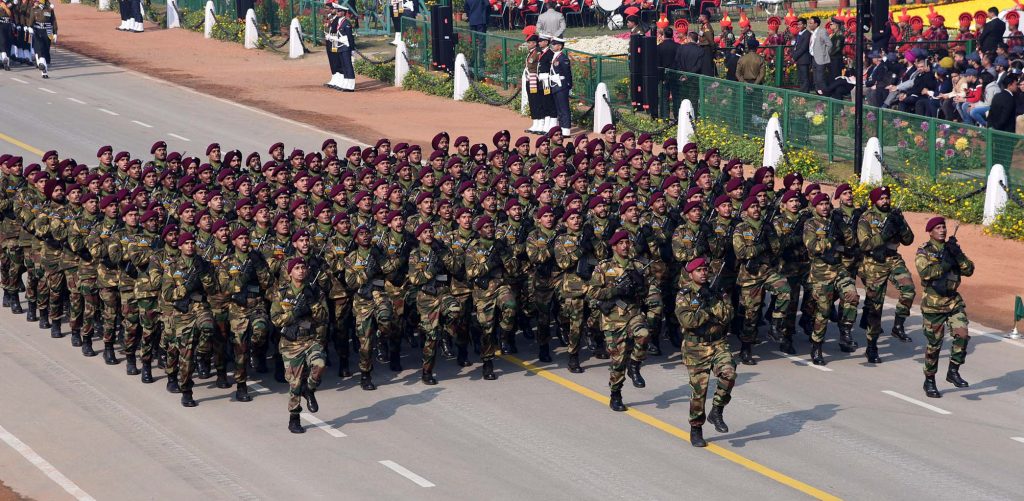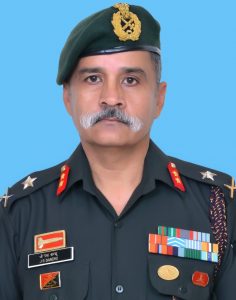
New Delhi. 26 October 2020. The parachute units of the Indian Army are among the oldest airborne units in the world. The 50th Indian Parachute Brigade was formed on 27 October 1941, comprising the British 151st Parachute Battalion, the British Indian Army 152nd Indian Parachute Battalion, and the 153rd Gurkha Parachute Battalion. The Parachute Regiment was formed from these and several other units in 1952.
In 1944, the 50th was allocated to the newly founded 44th Airborne Division. In the post-independence restructuring, India retained only one parachute brigade—the 50th. This brigade consisted of three distinguished battalions personally nominated by the then Commander-in-Chief, namely 1 PARA (Punjab), 2 PARA (Maratha) and 3 PARA (Kumaon). During the Jammu and Kashmir operations of 1947-48 these battalions distinguished themselves with glory in the battles of Shelatang, Naushera, Jhangar and Poonch, and were awarded the respective Battle Honours.
On 15 April 1952, the three battalions serving with the Parachute Brigade were removed from their respective Infantry Regiments to form the Parachute Regiment. Since then the Parachute Regiment has grown to comprise ten battalions including Parachute (Special Forces) battalions. In 1986, 8 PARA became 12 Battalion, Mechanised Infantry Regiment, while 21 Maratha LI converted to PARA (Special Forces). During their short but eventful existence so far, the regiment’s battalions have had extensive operational experience, and singular achievements, to speak of their level of professionalism.
During the Indo-Pakistani War of 1965, an ad hoc commando unit, named Meghdoot Force, consisting of volunteers from various infantry units was organized by then Major Megh Singh of the Brigade of the Guards. The unit performed well in combat, and the Government authorized the formal raising of a commando unit. Lt Col Megh Singh was selected to raise the unit which was originally intended to be a part of the Brigade of the Guards. However, recognizing parachute qualification as an integral element of special operations, the unit was transferred to the Parachute Regiment and raised as its 9th Battalion (Commando) on 1 July 1966. The erstwhile members of the Meghdoot Force formed the nucleus, and the new unit was based in Gwalior. In June 1967 the unit was split equally into two to form a second commando unit, designated as 10th Battalion, each with three Companies. 10th Battalion was mandated to operate in the Western Desert and 9th Battalion in the northern mountains. In 1969, these battalions were re-designated as 9 and 10 Para (Commando) battalions.
In 1978, the 1 Para, as an experiment, was converted to become the first special forces unit of the Indian army, and was kept as the tactical reserve. Already a recipient of the Chief of Army Staff Unit Citation twice, and the GOC-in-C Eastern Command Unit Citation once, the unit was originally 1 Punjab, which was later re-designated as 1 PARA (PUNJAB) and in 1978 was converted to 1 PARA (SF).
On 15 January 1992, the Parachute Regiment Training Centre along with the Records and PAO(OR), and the Para Regiment, moved to Bangalore and occupied the erstwhile location of Pioneer Corps and Training Centre. Bangalore is the new Key Location Project of the centre. 1995 saw the formation of the fourth commando battalion when 21 Maratha Light Infantry was selected to convert to special forces and slated for the Eastern Command. After a stringent selection and training process that spanned more than a year, on 1 February 1996, the unit under Colonel VB Shinde, was formally inducted as the 21st Battalion (Special Forces), The Parachute Regiment. The unit has done well in its short lifespan and is the proud recipient of the Chief of Army Staff Unit Citation twice (1992 and 2006) and the GOC-in-C Eastern Command Unit Citation once (2008), as well as a host of individual gallantry awards. With the changing scenario in military operations and the need for more special forces units, 2 Para began the conversion process from parachute to special forces role, followed closely by the 3 Para and the 4 Para in the year 2004 and 2005. The attempt did see some success, but the reason it failed to achieve its goal was due to the stringent selection process.
The Parachute Regiment presently has nine Special Forces, five Airborne, two Territorial Army and one Counter-Insurgency (Rashtriya Rifles) battalions in its fold. The regiment has tried raising new battalions to augment the strength of the special forces however the task has not been completed due to the tough selection phase. Furthermore, in the absence of a centralized command and lack of a centralized and standardized procedure for selection, even among the Para (SF) battalions, selection procedures vary. Meaning there is a different standard to get into different Para (SF) battalions.
In the mid-1980s, there were plans to take the three para commando battalions from the Parachute Regiment and bring them together under an individual specialized organisation, the Special Forces Regiment. However, after several logistic and administrative obstacles, these plans were abandoned, and they continue to be trained and recruited by the Parachute Regiment.
Para (SF) operate in assault teams, which work individually behind enemy lines, whereas the Paratroopers (Airborne) work in large teams and coordinate with other units as their role involves occupying large areas behind enemy lines. The total strength of the regiment stands at about 10,000, this includes five airborne infantry battalions, one Rashtriya Rifles and two Territorial Army battalion personnel, while the Para (SF) includes between 5,000 and 6,000 personnel. They have to hide their identity from general public.
Functions
- Intelligence collection, special reconnaissance
- sabotage of vital enemy infrastructure and communications through deep penetration and surgical strikes behind enemy lines.
- Covert and overt/direct action special operations as part of the Indian Army’s counter-terrorist and counter-insurgency operations.
- Hostage rescue operations within and beyond Indian territory.
- The unit is tasked with missions such as special operations, direct action, hostage rescue, counter-terrorism, special reconnaissance, foreign internal defense, counter-proliferation, counter-insurgency, seek and destroy and personnel recovery.
Selection
All Indian paratroopers are volunteers. Some enter the Para regiments fresh from recruitment, while others transfer in from regular army units. They are put through a probationary period / selection process of three months for Paratroopers (Airborne) Battalions (5,6,7,23,29) and six months for Para (Special Forces) battalions (1,2,3,4,9,10,11,12,21 PARA), in order to be a Para (Special Forces) all personnel are first required to qualify as Paratroopers; once selected the candidates may choose to advance to the SF selection, which takes place twice a year in the spring and the autumn term. It is one of the longest and tough training in the India, the candidates are exposed to sleep deprivation, humiliation, exhaustion, mental and physical torture. Deaths have been reported during this selection process. The attrition rate is very high, and selection rarely exceeds 15 percent. Even though a candidate may have cleared selection, he is not formally inducted into the regiment until completion of the Balidan Padh. After training, the candidates are involved in active operations in a hostile zone for a year. Provided if the candidates survives the Balidan Padh, they shall earn the Balidan Badge and formally get inducted into the regiment.
There are nine Para (SF) battalions and soldiers are selected accordingly. An example of this would be the 10 Para (SF) who are also known as Desert Scorpions. The probation period for this is six-month and the probationers are selected accordingly for desert warfare. The 9 Para (SF) who specialise in Mountain warfare go through a nine-month course at the Special Forces training centre in Nahan, Himachal Pradesh which is followed by further specialised selection. 1 Para specialises in mountain warfare. This concept of geographical specialisation was over time reduced and each Para (SF) battalion is trained to operate in various different terrains and climates.
Soldiers of the Indian Army volunteer for the course irrespective of rank. Depending on the battalion, the probation period varies from three months, six months or nine months, with additional time for specialized skills selection. Over the probation period, all soldiers are stripped of their ranks, including officers, and are known as probationers or probies. During any day of the course, a probationer can opt to leave the course. The completion rate is under 12-15 per cent and this slightly high completion rate is because many probationers are drawn from their regimental battalions. Each Special Forces operative specialises in various skills such as weapons, demolition, navigation, communication, medical. PARA (SF) work in small teams, five to eight men, and are also focused on strategic reconnaissance, surveillance, target designation (RSTAD) Hostage rescue and direct action (DA) tasks and are selected and trained accordingly. Those who complete the probation period and are inducted into the Para (SF) undergo further selection and training, but to earn the Balidan (sacrifice) badge, they have to further survive being deployed in active operations in hostile zones, known as the Balidan Padh.
There are four phases to become a Para (SF). First is Basic military training – to start the process a candidate first must join the Indian Army and complete the basic training requirements, which vary according to the training center and prospective role. Second is Pre-Selection – this stage encompasses administrative procedures and the soldier applying for the Para (Air) or Para (SF) and the necessary medical requirements. Third is Selection (encompassing a selection process and basic SF training) – the duration of this stage has changed over the years. For the Para (Air) it was initially 28 days which became 45 days after 1999 and is now 90 days (approximately 3 months). The Para (SF) was 90 days long and hasn’t been changed since. The intensity also differs according to the prospective battalion. Para (SF) selection takes place twice a year. Probationers undergo extreme physical and mental tests. The drop out rate is high. Those who fail go back to their parent regiment.
Fourth is Advanced SF Training – all those who opt for Para (SF) must first qualify for Para (Air). Although this is also a training phase, it is still part of the selection process. Here the soldiers undertake different kinds of training with various organisations overseen by the Parachute Regiment Training Centre and the Special Forces Training School. Training includes weapons handling training, land navigation and field craft training, infiltration, assault and ambush tactics, close quarter battle (CQB) training, urban warfare, counter-terrorism, unarmed combat training and various other courses across training centers of the Indian Defense Forces.
Info from Open Source & Wikipedia























































































































